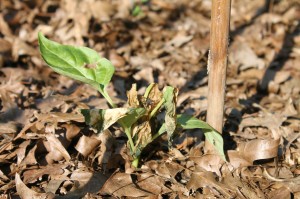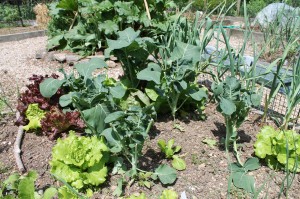A Nip of Frost
May 21st, 2013
Those couple of cold mid-May nights last week nipped the tips of some of my tender young peppers, tomatoes and basil.
That was only the second time that’s happened to me in nearly 30 years of gardening in the suburbs of Hampden Twp.
It’s rare around here to get frost damage beyond Mother’s Day. Most years, it’s safe sailing by the end of April.
What I usually do is hold off on planting the tender stuff (i.e. annual flowers and warm-weather veggies) until early May, then look at the 7-day forecasted lows.
When the overnight lows aren’t supposed to dip below 40, I plant – figuring that by the time we then get to mid-May, we’ll be at the all-time record late frost date for Harrisburg.
According to the area’s “official” weather records from Harrisburg International Airport, our all-time latest killing frost is May 11. The average last killing frost is April 20.
It’s not unusual for frosts to happen later than that to the north of here and in outlying areas, which is why Halifaxers and Newporters often wait until close to Memorial Day to plant their tomatoes and petunias.
What happened last week was a freak return to the freezing point after a string of normal above-freezing weather.
Fortunately, the episode wasn’t a heavy killer in my yard.
The damage was mostly to the tips of the young plants – and not even all of them.
What was odd was how one tomato had damage while another right next to it came out fine. I chalked it up to genetics and to slight variations in the reach of this borderline frost.
Plants will recover from tip damage. I just snipped off the blackened little stems and expect that within a few weeks, the plants will be growing normally.
A few peppers and three ‘Big Beef’ tomato seedlings keeled over completely.
That’s more of a problem, although I’ve seen some apparently fatal frost kills make miraculous comebacks.
In my case, I had saved a few extra tomato seedlings just in case and replanted with those. (I’m a believer in Murphy Law, as you’ll see from this post.)
If you didn’t have a backup supply, wait a week or two and see if you don’t notice new shoots emerging from your apparently dead plants.
In a way, this late brush with frost wasn’t too surprising since we’ve been off to a rather cool start so far this season.
I’m not complaining because it’s been perfect for the cool-season veggies. Most years, it’s been getting so warm so fast that the radishes turn hot and the broccoli tries to bolt to seed before growing full heads.
I’ve had one of my best radish harvests already… hundreds of bug-free red and pink orbs with a perfect mild flavor are safely nestled in my refrigerator crisper.
Lettuce is doing great.
Beets, carrots and kohlrabi are all well on their way.
And the cole crops were looking better than ever – until my latest brush with a groundhog.
I’ve battled my arch-nemesis species for decades and manage to fend off damage most of the time with a fence that’s secured at the bottom to buried lumber and left unsecured at the top to discourage climbing.
What happened was that I ordered a new arbor from a local company and waited until delivery day to take down the current, fence-secured gate.
But the arbor was a no-show. The company told me the gate wasn’t done yet when they went to pick it up.
So I put the gate and fence back together loosely and got back to work.
Two days later, half the cabbage, cauliflower, broccoli and brokali (a cross between broccoli and kale that I’m trialing) were chomped.
You can’t turn your back for a minute on the crafty groundhog. Give him even a slight opening and you’ll pay.
Even with the new arbor and secured gate now in place, I erected a second inner perimeter fence around the cole crops along with a Havahart trap baited with apples.
If that doesn’t do the trick, the groundhog can have my cabbage.
He apparently wants it more than I do.









